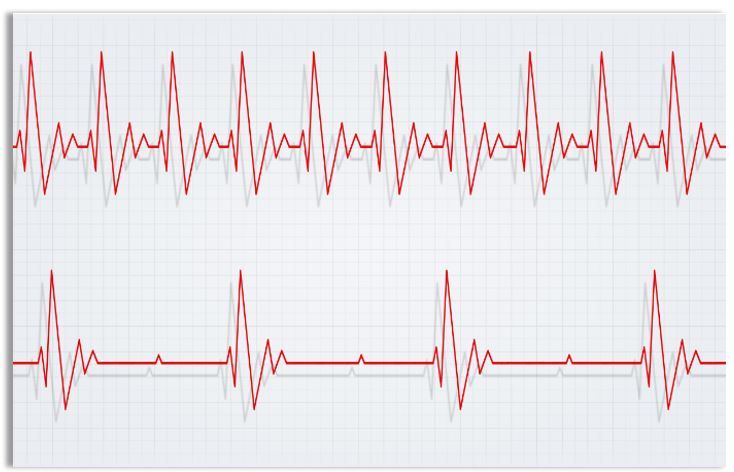- Clinical Technology
- Adult Immunization
- Hepatology
- Pediatric Immunization
- Screening
- Psychiatry
- Allergy
- Women's Health
- Cardiology
- Pediatrics
- Dermatology
- Endocrinology
- Pain Management
- Gastroenterology
- Infectious Disease
- Obesity Medicine
- Rheumatology
- Nephrology
- Neurology
- Pulmonology
COVID-19 Cardiac Sequelae Include Prolonged Tachycardia, Analysis of Wearable Data Finds
Using data from wearable devices that track physiologic changes caused by viral illness, researchers observed prolonged deviation from baseline resting heart rate in study participants.
©alex_aldo/stock.adobe.com

Resting heart rate (RHR) in patients who have had COVID-19 may not return to baseline level for up to >4 months, according to a research letter published online July 7, 2021, in JAMA Network Open. Based on analyses of data from wearable devices, investigators report prolonged physiologic impact of COVID-19 including in some study participants tachycardia that did not return to baseline RHR for >4.5 months.
Researchers, led by Jennifer M. Radin, PhD, MPH from the Scripps Research Translational Institute, San Diego, California say that while long-term autonomic dysfunction and cardiac damage following CVOID-19 infection have been reported for as long as 6 months after onset of symptoms, there is little research quantifying such symptoms.
Pointing to previous research that demonstrates effective use of wearable data to improve real-time detection of viral illness or discrimination between COVID-19 vs other viral infections, Radin, et al, mined data from wearable devices used by more than 37 000 participants. The devices, they note, provide continuous tracking of physiologic and behavioral metrics from health, through acute infection, to recovery to baseline.
The present study set out to examine the duration and variation of recovery among COVID-19–positive vs COVID-19–negative participants.
The study cohort was drawn from a remote, app-based, longitudinal research study (Digital Engagement and Tracking for Early Control and Treatment [DETECTT]). DETECT is enrolling adults from across the US and collecting wearable data to better understand individual changes associated with viral illness, including COVID-19.
The 37 146 participants in DETECT were enrolled between March 25, 2020, and January 24, 2021. Radin and colleagues focused analysis on 875 participants who reported symptoms of an acute respiratory illness. Swab testing of this group identified 234 individuals positive for COVID-19 and 641 individuals negative for the infection.
Among the 234 testing positive for COVID-19, mean age was 45.3 years (range, 18-76 years) and 70.9% were women; among the 641 who tested negative, mean age was 44.7 years (range, 19 to 75 years) and 71.1% were women.
RESULTS
Return to baseline RHR took longer for participants with COVID-19 compared with those who were symptomatic but COVID-19 negative. Individuals in the COVID-19 positive group also returned more slowly to baseline sleep and activity levels.
The difference in the length of the interval between baseline and return to baseline between COVID-positive and COVID-negative groups was greatest for RHR. The investigators describe an initial transient bradycardia in COVID-19 positive participants followed by a “prolonged relative tachycardia.” This elevated heart rate did not return to pre-infection baseline, on average, until 79 days after onset of symptoms.
Return to baseline measures was markedly more rapid for step count and sleep quantity, at t 32 and 24 days, respectively, vs RHR.
Radin and colleagues describe disparate trajectories between COVID-19 infected and non-infected participants in the return to normal RHR. In almost 14% (13.7%) of those recovering from the virus, RHR remained >5 beats per minute greater than baseline for >133 days. This group seemed more severely affected during the acute phase of COVID-19, reporting higher frequencies of cough, body aches, and shortness of breath than participants with lower mean HRH change from baseline during 28 to 56 days after symptom onset.
The authors say that, to their knowledge, this is the first study to examine “longer duration wearable sensor data” related to infection with SARS-CoV-2. Their finding of physiologic impact of COVID-19 infection lasting an average of 2 to 3 months includes significant intraindividual variability which, they suggest, may indicate “various levels of autonomic nervous system dysfunction or potentially ongoing inflammation.”
“Our data suggest that early symptoms and larger initial RHR response to COVID-19 infection may be associated with the physiological length of recovery from this virus,” write the authors.
They note, too, that because data collection took place during the acute phase of infection, their ability was limited to compare “long-term physiological and behavioral changes with long-term symptoms.” They recommend future studies with larger sample sizes and more comprehensive participant-reported outcomes to shed greater light on factors associated with variability in COVID-19 recovery.
